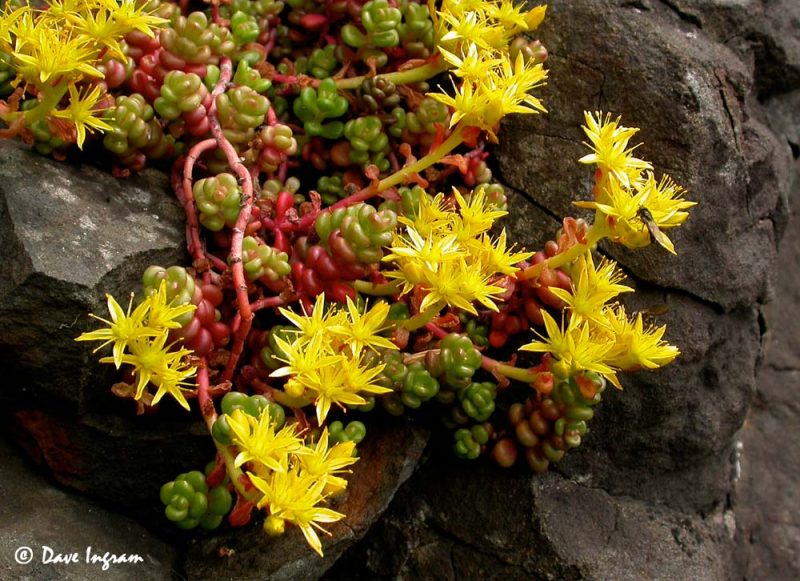Guest Post by Jocie Brooks
Whenever I come in my back door, I’m greeted by two pots of hardy native succulents that I planted last summer: Oregon stonecrop and broad-leaved stonecrop. Attractive rosettes of fleshy leaves have completely engulfed the pots, and I marvel at the vigour of these plants that thrive in wet winters and dry summers with no maintenance at all. With my busy lifestyle, a no-maintenance patio plant that looks great year-round is certainly a plus.

I was reading up on native stonecrops in the classic book “Wild Flowers of the Pacific Northwest” by Lewis Clark. Judging from his remarks about broad-leaved stonecrop, Clark was definitely taken with the plant:
All this beauty this treasure-plant possesses – besides a cast-iron constitution, complete freedom from pests, ability to creep up vertical rock faces yet never become invasive, an evergreen attractiveness; and if all this were not enough – a low-spreading canopy of brightest golden flowers that continue for a long period to gladden the grey rocks.
Sedums are in the Stonecrop family, or Crassulaceae, a group characterizered by fleshy, succulent leaves and drought-tolerance. Sedum comes from the Latin word sedeo meaning “to sit” – an appropriate name for the low-profile ground-hugging nature of these plants. According to “Plants of Coastal BC” by Pojar and McKinnon, Stonecrop comes from the Old English word stancrop meaning ‘that which is cropped, cut or gathered off stone.’
There are six species of sedum in BC, five of which occur on Vancouver Island, as well as a few exotic garden species that have gone wild. My personal favourite is broad-leaved stonecrop (Sedum spathulifolium), which becomes common south of our area, particularly from Nanaimo to Victoria and the Gulf Islands. Carpets of broad-leaved stonecrop can be seen on rocks, cliffs and seaside bluffs. The foliage is as attractive as the flowers; the small spoon-shaped leaves grow in crowded rosettes that are grey-green and rosy-red in the full sun. The leaves are often coated with a fine, waxy whitish powder that can be rubbed off with a fingertip.
Depending on whether the plant grows in a sunbaked hot spot or a shady nook, there can be quite a lot of colour variation in the foliage. Clark makes a reference to these colour subtleties: “Perhaps most beautiful of all are the less-frequently seen variations, of ice-green most alluringly edged with shades of lavender and mauve.”
In spring or early summer broad-leaved stonecrop blooms, producing flat-topped clusters of star-like yellow flowers. A large colony in bloom is spectacular- I remember driving through Goldstream Provincial Park on my way to Victoria, and noticing rock walls above the highway ablaze with the stonecrop’s blooms.

The Oregon stonecrop (Sedum oreganum) is less showy, but just as charming. The leaves are egg to spoon shaped and are usually green or tinged with bronze. Oregon stonecrop can be found on rocky outcrops, talus slopes and at the edges of forests. I’ve seen it growing abundantly on the rock bluffs above Buttle Lake in Strathcona Provincial Park. On Vancouver Island, spreading stonecrop (Sedum divergens) is the most commonly encountered species of the subalpine. Growing on cliffs, ledges and talus slopes, it has pudgy oval leaves that grow opposite each other. Like broad-leaved stonecrop, the leaves turn red in the hot sun. Further north along the coast, spreading stonecrop can be found at lower elevations and sea level.
From a human perspective, it may seem like the only use for sedum is as an attractive ground cover for the garden, but the stonecrops can offer us much more. Traditionally, sedums were harvested by many coastal First Nations peoples such as the Haida, who ate leaves of spreading stonecrop raw and called them ‘berries’. The plant was used medicinally for a variety of purposes; a tea was made to ease childbirth and a poultice of heated leaves was used to start the flow of a mother’s breast milk. Despite these traditional uses, caution should be advised when sampling these plants. According to Plants of Coastal BC: “the leaves of all stonecrops are edible, but should be eaten only in moderation since some have emetic and cathartic properties and can cause headaches”.
Green roofs, which are gaining favour in BC, make use of sedums and other drought-resistant native plants. Though expensive to install, green roofs have many benefits, including water retention, air quality improvement, soundproofing and insulation from both cold and heat. Furthermore, green roofs offer habitat and refuge for plants and other creatures. The newly opened Vancouver Island Visitor Centre near Courtenay’s Cumberland Interchange has recently had a green roof installed, comprised mainly of sedums. Similar green roofs have been installed elsewhere in BC, most notably the 6-acre roof of the Vancouver Convention Center which has the largest green roof in Canada.
Looking at my two pots of sedum, I realize that these small, tough plants have a lot to teach me. And the thought of a tapestry of sedums and other native plants covering more roofs in our town is something we can all envision.